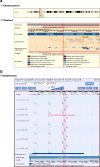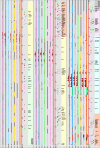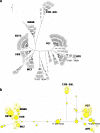Variation analysis and gene annotation of eight MHC haplotypes: the MHC Haplotype Project
- PMID: 18193213
- PMCID: PMC2206249
- DOI: 10.1007/s00251-007-0262-2
Variation analysis and gene annotation of eight MHC haplotypes: the MHC Haplotype Project
Abstract
The human major histocompatibility complex (MHC) is contained within about 4 Mb on the short arm of chromosome 6 and is recognised as the most variable region in the human genome. The primary aim of the MHC Haplotype Project was to provide a comprehensively annotated reference sequence of a single, human leukocyte antigen-homozygous MHC haplotype and to use it as a basis against which variations could be assessed from seven other similarly homozygous cell lines, representative of the most common MHC haplotypes in the European population. Comparison of the haplotype sequences, including four haplotypes not previously analysed, resulted in the identification of >44,000 variations, both substitutions and indels (insertions and deletions), which have been submitted to the dbSNP database. The gene annotation uncovered haplotype-specific differences and confirmed the presence of more than 300 loci, including over 160 protein-coding genes. Combined analysis of the variation and annotation datasets revealed 122 gene loci with coding substitutions of which 97 were non-synonymous. The haplotype (A3-B7-DR15; PGF cell line) designated as the new MHC reference sequence, has been incorporated into the human genome assembly (NCBI35 and subsequent builds), and constitutes the largest single-haplotype sequence of the human genome to date. The extensive variation and annotation data derived from the analysis of seven further haplotypes have been made publicly available and provide a framework and resource for future association studies of all MHC-associated diseases and transplant medicine.
Figures



References
-
- {'text': '', 'ref_index': 1, 'ids': [{'type': 'DOI', 'value': '10.1034/j.1399-0039.2002.590609.x', 'is_inner': False, 'url': 'https://doi.org/10.1034/j.1399-0039.2002.590609.x'}, {'type': 'PubMed', 'value': '12445322', 'is_inner': True, 'url': 'https://pubmed.ncbi.nlm.nih.gov/12445322/'}]}
- Allcock RJ, Atrazhev AM, Beck S, de Jong PJ, Elliott JF, Forbes S, Halls K, Horton R, Osoegawa K, Rogers J, Sawcer S, Todd JA, Trowsdale J, Wang Y, Williams S (2002) The MHC haplotype project: a resource for HLA-linked association studies. Tissue Antigens 59:520–521 - PubMed
-
- {'text': '', 'ref_index': 1, 'ids': [{'type': 'PubMed', 'value': '2231712', 'is_inner': True, 'url': 'https://pubmed.ncbi.nlm.nih.gov/2231712/'}]}
- Altschul SF, Gish W, Miller W, Myers EW, Lipman DJ (1990) Basic local alignment search tool. J Mol Biol 215:403–410 - PubMed
-
- {'text': '', 'ref_index': 1, 'ids': [{'type': 'DOI', 'value': '10.1073/pnas.77.6.3576', 'is_inner': False, 'url': 'https://doi.org/10.1073/pnas.77.6.3576'}, {'type': 'PMC', 'value': 'PMC349660', 'is_inner': False, 'url': 'https://pmc.ncbi.nlm.nih.gov/articles/PMC349660/'}, {'type': 'PubMed', 'value': '6932037', 'is_inner': True, 'url': 'https://pubmed.ncbi.nlm.nih.gov/6932037/'}]}
- Awdeh ZL, Alper CA (1980) Inherited structural polymorphism of the fourth component of human complement. Proc Natl Acad Sci U S A 77:3576–3580 - PMC - PubMed
-
- {'text': '', 'ref_index': 1, 'ids': [{'type': 'PubMed', 'value': '10331250', 'is_inner': True, 'url': 'https://pubmed.ncbi.nlm.nih.gov/10331250/'}]}
- Bandelt HJ, Forster P, Rohl A (1999) Median-joining networks for inferring intraspecific phylogenies. Mol Biol Evol 16:37–48 - PubMed
-
- {'text': '', 'ref_index': 1, 'ids': [{'type': 'DOI', 'value': '10.1093/nar/27.2.573', 'is_inner': False, 'url': 'https://doi.org/10.1093/nar/27.2.573'}, {'type': 'PMC', 'value': 'PMC148217', 'is_inner': False, 'url': 'https://pmc.ncbi.nlm.nih.gov/articles/PMC148217/'}, {'type': 'PubMed', 'value': '9862982', 'is_inner': True, 'url': 'https://pubmed.ncbi.nlm.nih.gov/9862982/'}]}
- Benson G (1999) Tandem repeats finder: a program to analyze DNA sequences. Nucleic Acids Res 27:573–580 - PMC - PubMed
Publication types
MeSH terms
Substances
Grants and funding
LinkOut - more resources
Full Text Sources
Other Literature Sources
Research Materials
Miscellaneous

